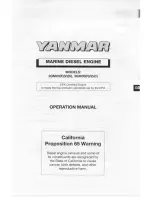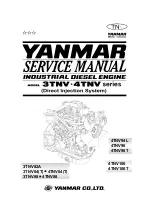
Detailed instructions on the rate of which the fuel
cleaner is to be used, are on the container.
Contamination Control
Recommendations for Fuels
Fuels of “ISO 18/16/13” cleanliness level or cleaner
as dispensed into the engine or application fuel tank
should be used. This action will reduce risk of power
loss, fuel system failures, and related down time of
engines. This cleanliness level is important for new
fuel system designs such as common rail injection
systems and unit injectors. These fuels systems
utilize higher fuel injection pressures and have tight
clearances between moving parts to meet required
stringent emissions regulations. Peak injection
pressures in current fuel injection systems may
exceed 2000 bar (29000 psi). Clearances in these
systems are less than 5 μm. As a result, particle
contaminants as small as 4 μm can cause scoring
and scratching of internal pump and injector surfaces
and of injector nozzle.
Water in the fuel causes cavitation, corrosion of fuel
system parts, and provides an environment where
microbial growth in the fuel can flourish. Other
sources of fuel contamination are soaps, gels, or
other compounds that may result from undesirable
chemical interactions in the fuels, particularly in
ULSD. Gels and other compounds can also form in
biodiesel fuel at low temperatures or if biodiesel is
stored for extended periods. The best indication of
microbial contamination, fuel additives, or cold
temperature gel is rapid filter plugging of bulk fuel
filters or application fuel filters.
To reduce downtime due to contamination, follow
these fuel maintenance guidelines.
• Use high-quality fuels per recommended and
required specifications
• Fill fuel tanks with fuels of “ISO 18/16/13”
cleanliness level or cleaner, in particular for
engines with common rail and unit injection
systems. When you refuel the tank, filter the fuel
through a 4 µm absolute filter (Beta 4 = 75 up to
200) to reach the recommended cleanliness level.
This filtration should be at the device that
dispenses the fuel to the fuel tank. In addition,
filtration at the dispensing point should remove
water to ensure that fuel is dispensed at 200 ppm
water or less.
• Perkins recommends the use of bulk fuel filter /
coalescer units which clean the fuel of both
particulate contamination and water in a single
pass.
• Ensure that you use Perkins Advanced Efficiency
Fuel Filters. Change your fuel filters per
recommended service requirements or as needed.
• Drain your water separators daily .
• Drain your fuel tanks of sediment and water. Refer
to Operation and Maintenance Manual, Fuel Tank
Water and Sediment - Drain for instructions.
• Install and maintain a properly designed bulk filter
/ coalescer filtration system. Continuous bulk
filtration systems may be required to ensure that
dispensed fuel meets the cleanliness target.
Consult your Perkins distributor for availability of
bulk filtration products.
• Centrifugal filters may need to be used as a pre-
filter with fuel that is severely contaminated with
gross amounts of water and/or large particulate
contaminants. Centrifugal filters can effectively
remove large contaminants, but may not be able
to remove the small abrasive particles required to
achieve the recommended “ISO” cleanliness level.
Bulk filter / coalescers are necessary as a final
filter to achieve the recommended cleanliness
level.
• Install desiccant type breathers of 4 µm or less
absolute efficiency with the ability to remove water
on bulk storage tanks.
• Follow proper practices of fuel transportation.
Filtration from the storage tank to the application
promotes the delivery of clean fuel. Fuel filtration
can be installed at each transport stage to keep
the fuel clean.
• Cover, protect, and ensure cleanliness of all
connection hoses, fittings, and dispensing
nozzles.
Consult your local Perkins distributor for additional
information on Perkins designed and produced
filtration products.
M0105633-01
47
















































